Edible gardens are traditionally backyard affairs. To some people, vegetables don’t have the elegance of flowers and shrubs. Well, to each their own. There are plenty of reasons why you might want to plant front-yard edibles this year.
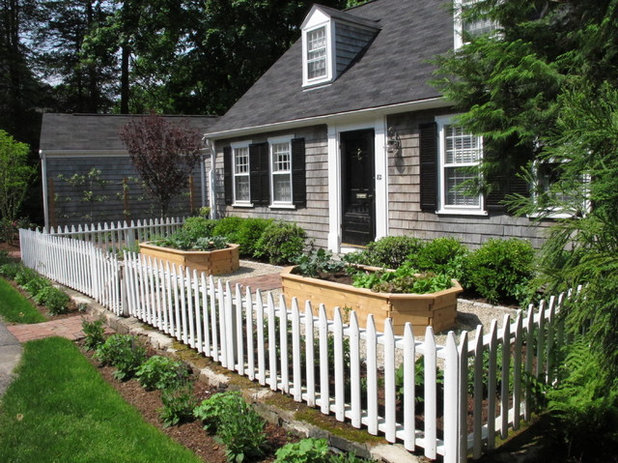
Nilsen Landscape Design, LLC
Why Grow Your Edibles in the Front YardTake advantage of available light. Vegetables need a lot of sunlight. Depending on the direction your house faces and even which side of the street you’re on, there’s a good chance you may have a shady north-facing backyard and a much sunnier front yard with southern exposure. If that’s the case for you, planting veggies in your front yard will maximize your opportunities for successful food growing.
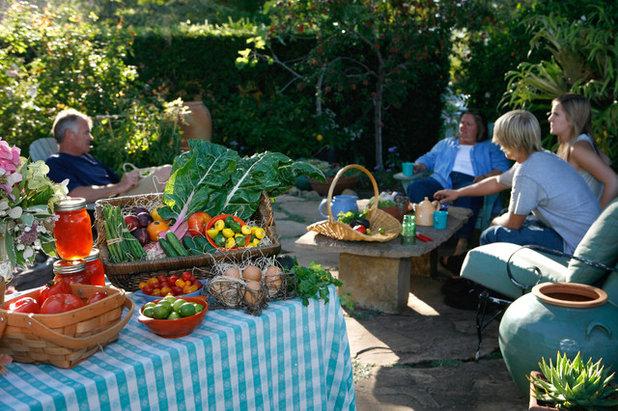
Margie Grace - Grace Design Associates
Get to know your neighbors. There’s something about a front-yard vegetable garden that gets people talking. Experienced gardeners might kindly offer their advice. Children will stop by to learn how plants grow. Would-be gardeners will ask questions about how you make your garden happen. In a world where urban dwellers are often isolated from their neighbors, growing a front-yard vegetable garden is a powerful way to engage with people.
Get ideas for designing a front-yard edible garden your neighbors will love
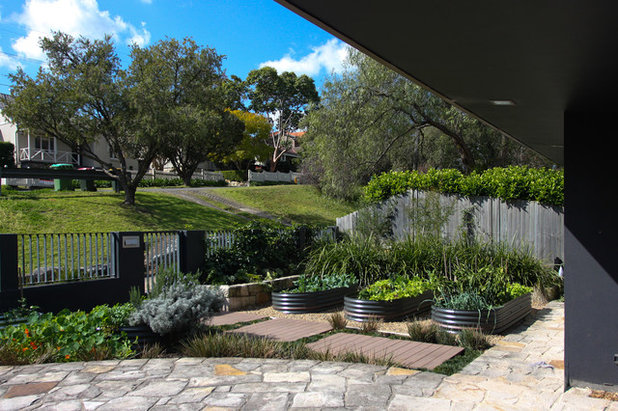
Sushiiphoto
Get rid of your lawn. No one likes mowing the lawn. And with temperatures on the rise, many cities are restricting or even banning watering grass, a notoriously thirsty plant. By reducing or eliminating your lawn and replacing it with a combination of perennial plants and veggies, you can transform your front yard into a more attractive, environmentally friendly space.
How to Replace Your Lawn With a Garden
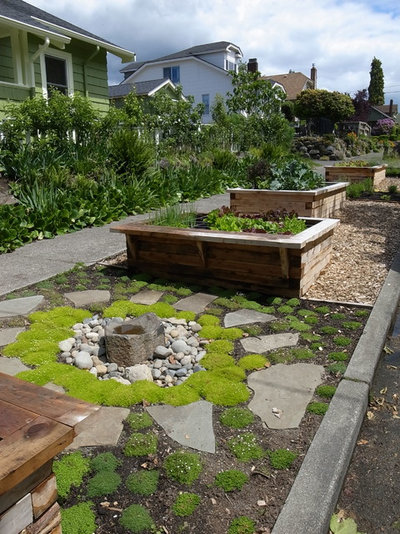
Erin Lau Landscape Design- Seattle
How to Design Your Front-Yard Edible Garden- Front-yard veggie gardens should fit your aesthetic and beautify your home. For some, that might mean building large raised beds and filling them with pea trellises, sunflowers and zucchini. For others, it may be preferable to plant mostly ornamental plants and include some containers of attractive herbs or a couple of small, dedicated beds for veggies.
- It can be tempting to mix veggies right in with ornamental plants, popping a couple of kale plants in among your flowers, for example. However, if you’re not an experienced gardener, it’s generally best to keep veggies separate from ornamental plants, especially perennials. Vegetables have their own needs, and mixing them with other types of plants can complicate things.
- Of course, just like many living things, some veggies go through an awkward stage. Garlic, for instance, needs to die back before it can be harvested, so you may want to place it in a less-conspicuous part of your front yard. Stay on top of thinning and harvesting your front-yard veggies, and remove any diseased plants or plant parts, so that your garden doesn’t become an eyesore for your neighbors.
- Many crops need protection from the elements, especially when they have just been planted. Low tunnels made from PVC pipes are great in backyards, but they might raise eyebrows in front yards. Instead, try using a movable cold frame to nurture delicate seedlings in the early spring and fall.
- Create an attractive bee-friendly oasis by including flowering herbs, like lavender. Not only will these help fruiting plants, like apples and zucchini, to have better yields, but you’ll be helping to restore your local environment.
See more of this parking-strip edible garden in Seattle
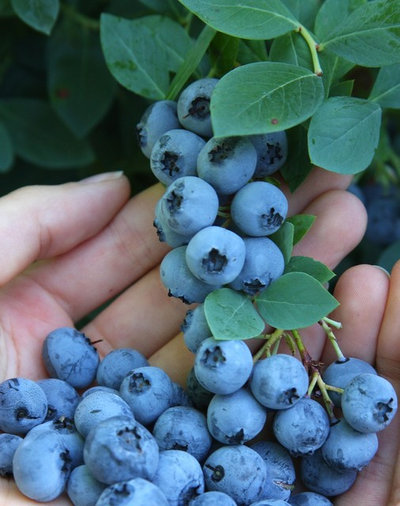
Monrovia
What to Grow in the Front YardFront-yard vegetables, fruits and herbs can be beautiful. The following crops are both gorgeous and edible.
- Blueberries. This relatively shade-tolerant fruit looks beautiful at all times of year, from bare red stems in the winter to delicate foliage that turns fiery orange in the fall. Choose from highbush or lowbush varieties depending on your preference. See how to grow blueberries.
- Mustard greens. Peppery, cold-tolerant mustard greens are a great addition to salads. These veggies grow easily from seed and range in shape and color from lime-green Tokyo bekana to feathery red mizuna. Try growing mustard greens in containers and planting a fresh round of seeds every week. See how to grow salad greens.
- Chives. These vigorous perennial herbs are incredibly easy to grow, and their grassy foliage and cheery flowers look great in a front yard. There’s nothing quite like chopping fresh chives for an omelette. Just keep in mind that chives can be invasive, so always plant them in containers. See how to grow chives.
- Chard. This stunning veggie, a member of the beet family, is known for its brightly colored stems. Chard grows easily from seed and doesn’t bolt in the heat, making it a classic for home gardens. See how to grow chard.
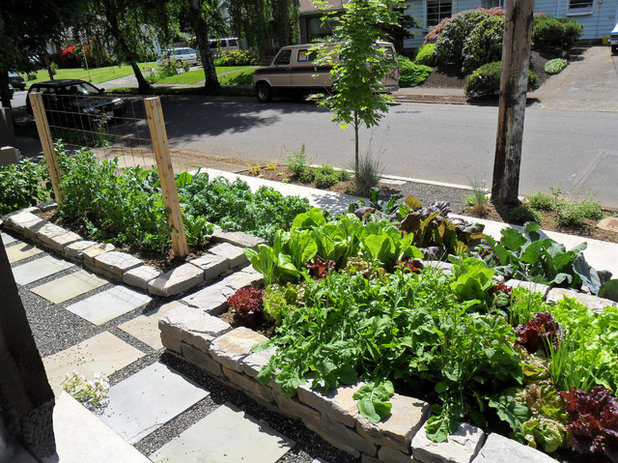
Plan-it Earth Design
Things to Consider- Front yards are usually more exposed than backyards. It’s a smart idea to get your soil professionally tested for heavy metals such as lead, especially if you’re near a busy road or have an older home. Search for a reputable soil laboratory in your area. In some cases, contaminants from house paint or car exhaust from the years before lead was banned can persist in the soil for decades. If your soil is contaminated, plant your veggies in containers or consider forgoing edibles altogether until you can remediate the situation. Consider planting a low hedge, or keeping your edibles back from the road, as shown here, to keep further car exhaust away from your veggies.
- Do what you can to keep animals, including cats, from using your front-yard garden as a toilet. Their droppings can contain harmful parasites, such as Toxoplasma gondii. In a backyard, row covers and chicken wire are useful ways to keep animals out of raised beds, but they usually don’t look good in a front yard. Planting your veggies in small containers rather than large raised beds may make your garden less attractive to neighborhood felines.
- Keep in mind that if you don’t have a fence, some of your produce might be eaten by hungry or curious neighbors. Decide whether or not this is going to be a problem for you. If it is, consider avoiding easy-to-identify plants, like tomatoes and berries.
- If you’re planning to grow a combination of vegetables and ornamental plants, take measures to ensure that edibles don’t get confused with poisonous ornamentals like delphiniums, especially if you’re gardening with kids. Give the veggies their own designated space, label your plants clearly and make sure family members are educated about what’s growing in the garden.
- Vegetable gardening doesn’t have to be relegated to your backyard. Enliven your home, and your community, by putting food front and center.





